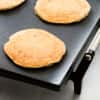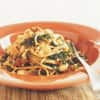Whole-Wheat Flour Swap
To achieve healthier muffins and cookies, how much whole wheat flour can be substituted before the texture is affected?
To find out, we made blueberry, bran, and corn muffins with all-purpose flour and compared them to muffins in which we substituted whole-wheat flour in increments of 25 percent, 50 percent, and 75 percent. We also baked chocolate chip, peanut butter, and brown sugar cookies, comparing them to cookies in which we subbed in the same percentages of whole-wheat flour. In every application, most tasters found anything beyond 25 percent whole-wheat flour unappealing. Any more and the muffins and cookies become so tough, dense, and chewy that only the most die-hard whole-wheat enthusiasts gave them a thumbs-up.
The starting point for our Whole Wheat Sandwich Bread (March/April 2011) was an ordinary white sandwich-loaf recipe in which we incrementally replaced the white flour with the whole-wheat kind. We found that every time we upped the whole wheat, we also had to increase the water in the recipe or the bread turned out overly dry. This is because the bran and germ in whole-wheat flour absorb more water than the nearly pure starch in white flour.
Whole-wheat flour is ground from the whole berry—the outer bran layer, the germ, and the endosperm (the heart of the wheat berry)—whereas all-purpose flour is ground from just the endosperm. While the germ layer gives whole-wheat flour more protein than all-purpose flour gets from just the endosperm, it does not form gluten. Gluten provides lift and structure to baked goods, so less of it means a denser crumb. Additionally, the germ and bran particles in whole-wheat flour contribute to greater chewiness. Whole-wheat flour holds about 13 percent more water by weight than white flour. In practical terms, this means that if you want to replace some of the white flour with whole wheat in a given baked goods recipe - whether for bread, muffins, or cookies - you'll need to use either more water or less flour to avoid dryness. The simplest approach is to add liquid. We found that this approach will not affect the texture of the final product (aside from the coarser quality whole wheat lends to baked goods).
For the best results in recipes calling for all-purpose flour only, don’t substitute with more than 25 percent whole-wheat flour or texture will suffer. If you want to bake with more whole-wheat flour, you will need recipes specifically designed for this goal.
LESS WHOLE WHEAT, AIRY CRUMB
MORE WHOLE WHEAT, DENSE CRUMB


